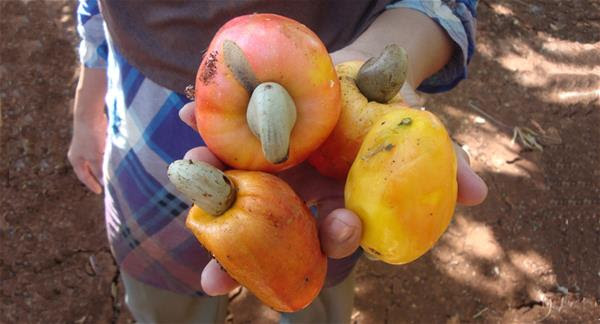Cyrilla Suwarsa grew up in Indonesia eating her grandma’s roasted cashews. Now, inspired by grandma’s recipes, she and her sister roast Indonesian cashews. They start with great nuts. They roast them in tiny batches. And the results are really, really good.
Cashews aren’t just a nut. They’re also a fruit.
They grow in tropical climates on cashew trees. The trees looks kind of like apple trees: stately, round foliage hiding yellow and red fruits (which, incidentally, are called cashew apples). Cashew apples look like bell peppers, except they hang off the tree upside down from what we’d call the bottom of the pepper and in place of the pepper’s stem there’s a dark grey shell shaped like a big lima bean. The fruit is sweet, astringent, super juicy. It’s also very delicate and doesn’t survive traveling, so unless you visit a cashew farm you’re unlikely to come across any cashew apples. The cashew nut is the seed of the fruit, and it’s locked inside that bean shaped shell.
Getting the nut out of that shell is difficult—and dangerous. First you need to heat the nuts up. Traditionally that would be done by sun drying, a method that’s slow but uses that time to amplify the flavor of the nuts. That’s what the farmers in Indonesia do for Cyrilla’s cashews. However, these days many producers use steam kettles or furnaces. The heat is important because cashew shells are super hard to crack, and the heat makes them slightly easier to break into. Once you do crack into them you have to be careful because the shells are filled with the same noxious compound that makes poison ivy poisonous—if you touch it, you’ll probably get a rash. These days most producers use big machines to crack open the cashews, but Cyrilla’s sources do it by hand, using a tool that looks like a machete and a sturdy pair of gloves. Once the shell has been removed, there’s still a peel that needs to be scraped off—another step that Cyrilla’s farmers do by hand. After all that, you finally get to the edible nut. With so much difficult, potentially painful processing required to get to anything edible, it makes me wonder how anyone figured out that you could eat the nut in the first place.
Cyrilla Suwarsa didn’t plan to sell roasted cashews.
Though she grew up eating her grandma’s roasted cashews at home in Indonesia. Then a few years ago, Cyrilla’s sister got a call from a friend in central Java. There was a nearby farm growing cashews for a cosmetics company. The company only wanted the fruit, which they used in a moisturizer. The nuts were getting discarded and it seemed like a waste—would they like to buy some of them? In the spirit of helping out, Cyrilla’s sister said she’d take “a little” and bought 100 kilos—roughly 220 pounds. “I don’t think she realized how much 100 kilos really is,” Cyrilla recalls. “A while later, these two human-sized bags full of cashews showed up on her doorstep.” To use them, they started roasting them with spices and seasonings using their grandma’s recipes. Everyone who tried them loved them. Before long Cyrilla and her sister were roasting cashews full time.
Cyrilla takes all the little steps to produce some seriously flavorful cashews.
For starters, she uses really flavorful cashews. These days she gets the nuts from three small family farms (including the one who sent her those very first nuts), all in central Java. The cashews from that area are a bit smaller than you find elsewhere, but they have a particularly buttery, sweet flavor.
The farmers all use very traditional methods of processing, including sun drying the nuts. But the biggest impact probably comes from one simple step. Unlike pretty much all of the cashews on the market which are shelled and sold right after harvesting, the farmers Cyrilla works with don’t shell the cashews until she places an order. Storing the nuts in the shells preserves their flavor and prevents them from going rancid.
The cashews are roasted in tiny batches—just 13 pounds at a time. They roast low and slow—it takes a full day of roasting for every batch. For half of the day, the nuts roast plain. Then they come out of the roasters and the seasonings get added in: coconut oil, chili, sugar, garlic, sea salt, and lime leaves that come from her family’s lime tree. After a couple of hours mixing, mingling and marinating, the cashews and seasonings go back to roast for another half a day.
All the little steps make for outrageously good flavor.
The texture is outstanding, first crunchy and then creamy. But it’s the flavor that really steals the show. They’re rich and nutty, a little sweet, bright and a bit citrusy from the lime leaves, and just spicy enough from the chili. It’s way too easy to eat a bag all in one go, especially if they’re rinsed down with a nice cold beer.
If you have some self-restraint, they’re also a killer secret ingredient. Crumble them up to sprinkle on pad Thai or a curry. Use those crumbles to coat chicken or fish. Stir them into homemade trail mix. Toss a few on a bowl of dark chocolate gelato. Or use them like Cyrilla does: put them in the blender with a little warm water and mix them up to make a rich sauce to use with chicken satay or to dress a bowl of soba noodles.

